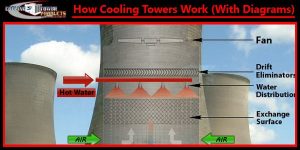What are common preventive maintenance schedules and checklists for a cooling tower?
Common preventive maintenance for cooling towers ensures circulating water is clean and regular maintenance keeps fans and motors functional. Various maintenance tasks require daily, weekly, monthly or annual performance.
What are Cooling Towers?
Cooling towers work to move heat between air and water to create a heat exchange.
Direct or open coolers essentially use evaporation to remove heat. Equipment sprays the heating component over the cooler before the air is blown through the area. Heat rises and evaporates into the outside air while remaining water circulates back to the chiller.
Indirect or closed coolers move the heated and cooled air through tubes within the system where heat is released. In this system, the water and air circulating do not contact the outside atmosphere. In both systems, either propeller or squirrel-cage fans move the air through the system.

Introduction to Cooling Tower Maintenance
Cooling towers must ensure that circulating water is clean to prevent bacteria growth, which can cause serious health problems. In addition, technicians must clean, inspect, lubricate, and adjust all of the motors, fans, and pumps within the cooling tower on a regular basis.
Any maintenance issue that reduces the efficiency of the system can cost energy and money. However, blowdown losses represent the greatest area of loss for cooling towers. Maintenance technicians can work to maximize cycles of concentration, monitor flow meters, or use chemical treatments to reduce blowdown losses.
Preventive Maintenance Checklist
Preventive maintenance tasks on cooling towers should be conducted daily, weekly, semi-annually or annually, depending on the task.
Each day, technicians should perform an overall visual inspection when they sequence coolers and ensure that water is flowing appropriately.
Check and adjust suction screens, belts, and pulleys on a weekly basis. Also weekly, test water quality. It’s important to check for temperature issues and excessive vibration in motors, fans, and pumps weekly as well. However, you may want to invest in sensor technology, which can monitor temperature and vibration around the clock. If temperature and vibration fall out of range, the machines send an alert to a central computer system. You can then address these discrepancies immediately.
Adress lubrication, wear, alignment and scale build-up on a monthly basis. At least once a year, inspect bearings and thoroughly clean all parts of the cooling tower.
Here is the preventive maintenance checklist from the US Department of Energy to guide your cooling tower maintenance:
More top checklists:
Want to keep reading?
The Optimum Preventive Maintenance Schedule: 7 Steps for Efficient and Effective Preventive Maintenance Planning and Scheduling
What are some maintenance planning best practices?
Maintenance Technician
4,000+ COMPANIES RELY ON ASSET OPERATIONS MANAGEMENT
Leading the Way to a Better Future for Maintenance and Reliability
Your asset and equipment data doesn't belong in a silo. UpKeep makes it simple to see where everything stands, all in one place. That means less guesswork and more time to focus on what matters.

![[Review Badge] Gartner Peer Insights (Dark)](https://www.datocms-assets.com/38028/1673900494-gartner-logo-dark.png?auto=compress&fm=webp&w=336)
